An Agent-Based Simulation of How Promotion Biases Impact Corporate Gender Diversity
Abstract
Featured Application
Abstract
1. Introduction
2. Background
2.1. Gender Biases in the Workplace
2.2. Simulating Corporate D&I
3. The Simulation
3.1. Core Elements of Our Simulation
3.1.1. Simulating the Hiring Process
3.1.2. Simulating the Promotion Process
3.1.3. Simulating the Separation Process
4. Simulation Setup
4.1. Simulation Time Step and Duration
4.2. Randomness
4.3. Company Size and Employee Distributions
4.4. Company Growth and Separation Rates
4.5. Promotion and Separation Pools
4.6. Employee Characteristics and Variables
4.7. Scenario-Testing Parameters
- Hiring Bias: This parameter determines the proportion of men and women that are hired when vacancies occur at the entry level. A positive bias means men are favored and a negative bias means women are favored.
- Promotion Bias: This parameter is added to the seniority of each simulated employee to influence the probability that the employee will be included in the candidate pool when a promotion takes place. A positive bias means men are favored and a negative bias means women are favored. The bias is expressed as a number between 0.0 and 1.0 which is added directly to each employee’s normalized seniority in their rank.
- Promotion Bias Duration: For some of the scenarios we tested, the promotion bias was set to zero after a certain amount of time (typically 10 years) to simulate the removal of all gender biases in promotions and separations. This parameter specifies the time when the promotion bias is turned to zero.
5. Results
5.1. Experiment 1: The Impact of Gender Biases in Promotion
5.2. Experiment 2: Combining Promotion and Hiring Biases to Match Industry-Specific Imbalances
Accuracy of the Industry Simulations
5.3. Experiment 3: The Impact of Removing All Biases
5.4. Experiment 4: The Impact of Promotion Biases on Individual Employees
6. Discussion
6.1. The Nature of Gender Biases
6.2. Benefits of Agent-Based Simulation as a Management Tool
6.3. Future Research Directions
Author Contributions
Funding
Institutional Review Board Statement
Informed Consent Statement
Data Availability Statement
Conflicts of Interest
References
- Dezsö, C.L.; Ross, D.G. Does female representation in top management improve firm performance? A panel data investigation. Strateg. Manag. J. 2012, 33, 1072–1089. [Google Scholar] [CrossRef]
- Flabbi, L.; Macis, M.; Moro, A.; Schivardi, F. Do female executives make a difference? The impact of female leadership on gender gaps and firm performance. Econ. J. 2019, 129, 2390–2423. [Google Scholar] [CrossRef]
- Hunt, V.; Yee, L.; Prince, S.; Dixon-Fyle, S. Delivering through Diversity. 2018. Available online: https://www.mckinsey.com/capabilities/people-and-organizational-performance/our-insights/delivering-through-diversity (accessed on 7 February 2023).
- Biagetti, M.; Scicchitano, S. A note on the gender wage gap among managerial positions using a counterfactual decomposition approach: Sticky floor or glass ceiling? Appl. Econ. Lett. 2011, 18, 939–943. [Google Scholar] [CrossRef]
- Blau, F.D.; Kahn, L.M. The Gender Pay Gap: Have Women Gone as Far as They Can? Acad. Manag. Perspect. 2007, 21, 7–23. [Google Scholar] [CrossRef]
- Becker-Blease, J.; Elkinawy, S.; Hoag, C.; Stater, M. The Effects of Executive, Firm, and Board Characteristics on Executive Exit. Financ. Rev. 2016, 51, 527–557. [Google Scholar] [CrossRef]
- Shaffer, M.A.; Joplin, J.R.W.; Bell, M.P.; Lau, T.; Oguz, C. Gender Discrimination and Job-Related Outcomes: A Cross-Cultural Comparison of Working Women in the United States and China. J. Vocat. Behav. 2000, 57, 395–427. [Google Scholar] [CrossRef]
- Hirsh, E. Do Lawsuits Improve Gender and Racial Equality at Work? 2019. Available online: https://hbr.org/2019/11/do-lawsuits-improve-gender-and-racial-equality-at-work (accessed on 2 February 2023).
- Hirsh, E.; Cha, Y. For Law and Markets: Employment Discrimination Lawsuits, Market Performance, and Managerial Diversity. Am. J. Sociol. 2018, 123, 1117–1160. [Google Scholar] [CrossRef]
- Bain, O.; Cummings, W. Academe′s Glass Ceiling: Societal, Professional-Organizational, and Institutional Barriers to the Career Advancement of Academic Women. Comp. Educ. Rev. 2000, 44, 493–514. [Google Scholar] [CrossRef]
- Jokinen, J.; Pehkonen, J. Promotions and Earnings—Gender or Merit? Evidence from Longitudinal Personnel Data. J. Labor Res. 2017, 38, 306–334. [Google Scholar] [CrossRef]
- Woetzel, J.; Madgavkar, A.; Ellingrud, K.; Labaye, E.; Devillard, S.; Kutcher, E.; Manyika, J.; Dobbs, R.; Krishnan, M. The Power of Parity: How Advancing Women′s Equality can Add $12 Trillion to Global Growth. 2015. Available online: https://www.mckinsey.com/featured-insights/employment-and-growth/how-advancing-womens-equality-can-add-12-trillion-to-global-growth (accessed on 2 February 2023).
- Bonabeau, E. Agent-based modeling: Methods and techniques for simulating human systems. Proc. Natl. Acad. Sci. USA 2002, 99, 7280–7287. [Google Scholar] [CrossRef]
- Waldrop, M.M. Complexity: The Emerging Science at the Edge of Order and Chaos; Simon and Schuster: New York, NY, USA, 1992. [Google Scholar]
- Gaudiano, P. The Best Approach to Decision Making Combines Data and Managers Expertise. 2017. Available online: https://hbr.org/2017/06/the-best-approach-to-decision-making-combines-data-and-managers-expertise (accessed on 2 February 2023).
- Liang, X.; Luo, L.; Hu, S.; Li, Y. Mapping the knowledge frontiers and evolution of decision making based on agent-based modeling. Knowl. Based Syst. 2022, 250, 108982. [Google Scholar] [CrossRef]
- North, M.J.; Macal, C.M. Managing Business Complexity: Discovering Strategic Solutions with Agent-Based Modeling and Simulation; Oxford University Press: Oxford, UK, 2007. [Google Scholar]
- Garagic, D.; Trifonov, I.; Gaudiano, P.; Dickason, D. An agent-based modeling approach for studying manpower and personnel management behaviors. In Proceedings of the 2007 Winter Simulation Conference, Washington, DC, USA, 9–12 December 2007. [Google Scholar]
- Gaudiano, P.; Hunt, E. Equal Opportunity or Affirmative Action? A Computer Program Shows Which Is Better for Diversity. 2016. Available online: https://www.forbes.com/sites/gaudianohunt/2016/08/22/equal-opportunity-or-affirmative-action-a-computer-program-shows-which-is-better-for-diversity/ (accessed on 2 February 2023).
- Rachid, B.; Mohamed, T.; Khouaja, M.A. An agent based modeling approach in the strategic human resource Management, including endogenous and exogenous factors. Simul. Model. Pract. Theory 2018, 88, 32–47. [Google Scholar] [CrossRef]
- Gender Equity in the Workplace Report; Linkedin. Available online: https://linkedin.github.io/gender-equity-2022/ (accessed on 2 February 2023).
- Hinchliffe, E. Women CEOs Run More Than 10% of Fortune 500 Companies for the First Time in History. 2023. Available online: https://fortune.com/2023/01/12/fortune-500-companies-ceos-women-10-percent/ (accessed on 2 February 2023).
- Bielby, W.T.; Baron, J.N. Men and Women at Work: Sex Segregation and Statistical Discrimination. Am. J. Sociol. 1986, 91, 759–799. [Google Scholar] [CrossRef]
- Matsa, D.A.; Miller, A.R. Chipping away at the Glass Ceiling: Gender Spillovers in Corporate Leadership. Am. Econ. Rev. 2011, 101, 635–639. [Google Scholar] [CrossRef]
- Olson, C.A.; Becker, B.E. Sex Discrimination in the Promotion Process. Ind. Labor Relat. Rev. 1983, 3, 624–641. [Google Scholar] [CrossRef]
- Kossek, E.E.; Su, R.; Wu, L. “Opting Out” or “Pushed Out”? Integrating Perspectives on Women’s Career Equality for Gender Inclusion and Interventions. J. Manag. 2017, 43, 228–254. [Google Scholar] [CrossRef]
- Niederle, M.; Vesterlund, L. Do women shy away from competition? Do men compete too much? Q. J. Econ. 2007, 122, 1067–1101. [Google Scholar] [CrossRef]
- Gjerde, K.A.P. The existence of gender-specific promotion standards in the U.S. Manag. Decis. Econ. 2002, 23, 447–459. [Google Scholar] [CrossRef]
- Lyness, K.S.; Heilman, M.E. When fit is fundamental: Performance evaluations and promotions of upper-level female and male managers. J. Appl. Psychol. 2006, 91, 777–785. [Google Scholar] [CrossRef] [PubMed]
- Vinkenburg, C.J.; van Engen, M.L.; Eagly, A.H.; Johannesen-Schmidt, M.C. An exploration of stereotypical beliefs about leadership styles: Is transformational leadership a route to womens promotion? Leadersh. Q. 2011, 22, 10–21. [Google Scholar] [CrossRef]
- Krivkovich, A.; Nadeau, M.-C.; Robinson, K.; Robinson, N.; Starikova, I.; Yee, L. Women in the Workplace. 2022. Available online: https://www.mckinsey.com/featured-insights/diversity-and-inclusion/women-in-the-workplace (accessed on 2 February 2023).
- Wall, F. Agent-based modeling in managerial science: An illustrative survey and study. Rev. Manag. Sci. 2016, 10, 135–193. [Google Scholar] [CrossRef]
- Schelling, T.C. Models of Segregation. Am. Econ. Rev. 1969, 59, 488–493. [Google Scholar]
- Epstein, J.M.; Axtell, R. Growing Artificial Societies: Social Science from the Bottom Up; Brookings Institution Press: Washington, DC, USA, 1996. [Google Scholar]
- Fioretti, G. Agent-based simulation models in organization science. Organ. Res. Methods 2013, 16, 227–242. [Google Scholar] [CrossRef]
- Page, S. The Diversity Bonus; Princeton University Press: Princeton, NJ, USA, 2017. [Google Scholar]
- Bullinaria, J. Agent-Based Models of Gender Inequalities in Career Progression. JASSS 2018, 21, 7. [Google Scholar] [CrossRef]
- Takács, K.; Squazzoni, F.; Bravo, G. The network antidote: An agent-based model of discrimination in labor markets. In Proceedings of the MKE 2012 Conference, Budapest, Hungary, 20 December 2012. [Google Scholar]
- Robison-Cox, J.F.; Martell, R.F.; Emrich, C.G. Simulating gender stratification. JASSS 2007, 10, 8. [Google Scholar]
- Zhang, C.; Gaudiano, P. An agent-based simulation of corporate gender biases. In Proceedings of the Future Technologies Conference (FTC) 2019, San Francisco, CA, USA, 25–26 October 2019; Volume 1, pp. 90–106. [Google Scholar]
- Kalev, A.; Dobbin, F.; Kelly, E. Best Practices or Best Guesses? Assessing the Efficacy of Corporate Affirmative Action and Diversity Policies. Am. Sociol. Rev. 2006, 71, 589–617. [Google Scholar] [CrossRef]
- Duzevik, D.; Anev, A.; Funes, P.; Gaudiano, P. The effects of word-of-mouth: An agent-based simulation of interpersonal influence in social networks. In 2007 Word of Mouth Research Symposium; Icosystem Corporation: Cambridge, MA, USA, 2007; Available online: http://www.icosystem.com/the-effects-of-word-of-mouth-an-agent-based-simulation-of-interpersonal-influence-in-social-networks/ (accessed on 2 February 2023).
- Gaudiano, P. Understanding Attribution from the Inside Out. 2016. Available online: https://www.exchangewire.com/blog/2016/05/16/understanding-attribution-from-the-inside-out/ (accessed on 2 February 2023).
- Gaudiano, P. Agent-based simulation as a tool for the built environment. Ann. New York Acad. Sci. 2013, 1295, 26–33. [Google Scholar] [CrossRef] [PubMed]
- Gaudiano, P.; Bandte, O.; Duzevik, D.; Anev, D. How word-of-mouth impacts medicare product launch and product design. In Proceedings of the Word of Mouth Marketing Summit (WOMMA’07), Las Vegas, NV, USA, 2007. [Google Scholar]
- Shargel, B.; Bonabeau, E.; Budynek, J.; Gaudiano, P. An Evolutionary, Agent-Based Model to Aid in Computer Intrusion Detection and Prevention; Icosystem Corp.: Cambridge, MA, USA, 2005. [Google Scholar]
- Wilensky, U.; Rand, W. An Introduction to Agent-Based Modeling: Modeling Natural, Social, and Engineered Complex Systems with NetLogo; MIT Press: Cambridge, MA, USA, 2015. [Google Scholar]
- Mills, D.Q. Seniority versus ability in promotion decisions. ILR Rev. 1985, 38, 421–425. [Google Scholar] [CrossRef]
- Andre, L. Employee Turnover Statistics: 2023 Causes, Cost & Prevention Data. 2023. Available online: https://financesonline.com/employee-turnover-statistics/ (accessed on 2 February 2023).
- Lehtonen, E.E.; Nokelainen, P.; Rintala, H.; Puhakka, I. Thriving or surviving at work: How workplace learning opportunities and subjective career success are connected with job satisfaction and turnover intention? J. Workplace Learn. 2022, 34, 88–109. [Google Scholar] [CrossRef]
- Miller, J.G.; Wheeler, K.G. Unraveling the mysteries of gender differences in intentions to leave the organization. J. Organ. Behav. 1992, 13, 465–478. [Google Scholar] [CrossRef]
- Mercer. North American Employee Turnover: Trends and Effects. 2020. Available online: https://www.imercer.com/articleinsights/north-american-employee (accessed on 2 February 2023).
- Chamorro-Premuzic, T. Why Do So Many Incompetent Men Become Leaders? (And How to Fix It); Harvard Business Review Press: Boston, MA, USA, 2019. [Google Scholar]
- Oluo, I. Mediocre: The Dangerous Legacy of White Male America; Seal Press: New York, NY, USA, 2020. [Google Scholar]
- Cavaleros, C.; Van Vuuren, L.J.; Visser, D. The effectiveness of a diversity awareness training programme. SA J. Ind. Psychol. 2002, 28, 50–61. [Google Scholar] [CrossRef]
- Dobbin, F.; Kalev, A. Getting to Diversity: What Works and What Doesn’t; Harvard University Press: Cambridge, MA, USA, 2022. [Google Scholar]
- Duguid, M.M.; Thomas-Hunt, M.C. Condoning stereotyping? How awareness of stereotyping prevalence impacts expression of stereotypes. J. Appl. Psychol. 2015, 100, 343–359. [Google Scholar] [CrossRef] [PubMed]
- Stamarski, C.S.; Son Hing, L.S. Gender inequalities in the workplace: The effects of organizational structures, processes, practices, and decision makers’ sexism. Front. Psychol. 2015, 6, 1400. [Google Scholar] [CrossRef] [PubMed]
- Holtom, B.C.; Mitchell, T.R.; Lee, T.W.; Inderrieden, E.J. Shocks as causes of turnover: What they are and how organizations can manage them. Hum. Resour. Manage. 2005, 44, 337–352. [Google Scholar] [CrossRef]
- Banaji, M.R.; Bazerman, M.H.; Chugh, D. How (Un)ethical Are You? Harv. Bus. Rev. 2003, 81. Available online: https://hbr.org/2003/12/how-unethical-are-you (accessed on 2 February 2023).
- Somarathna, K.U.S. An agent-based approach for modeling and simulation of human resource management as a complex system: Management strategy evaluation. Simul. Model. Pract. Theory 2020, 104, 102118. [Google Scholar] [CrossRef]
- Newkirk, P. Diversity, Inc.: The Failed Promise of a Billion-Dollar Business; Bold Type Books: New York, NY, USA, 2019. [Google Scholar]
- Naghdi Tam, A. Agent-Based Simulation as a Tool for Examining the Impact of a Company’s Reputation on Attracting Diverse Talent. Master’s Thesis, City College of New York, New York, NY, USA, 2017. [Google Scholar]
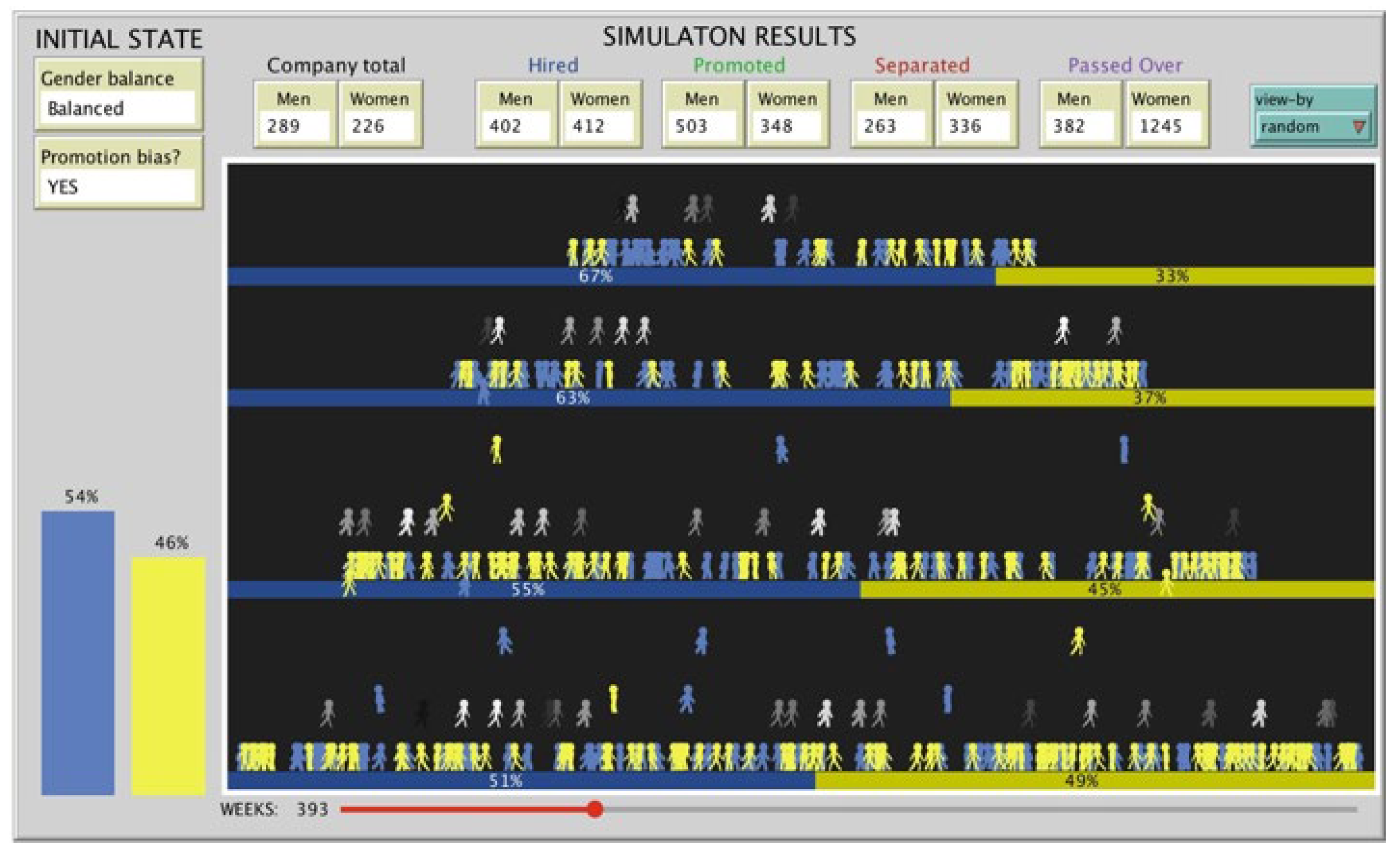
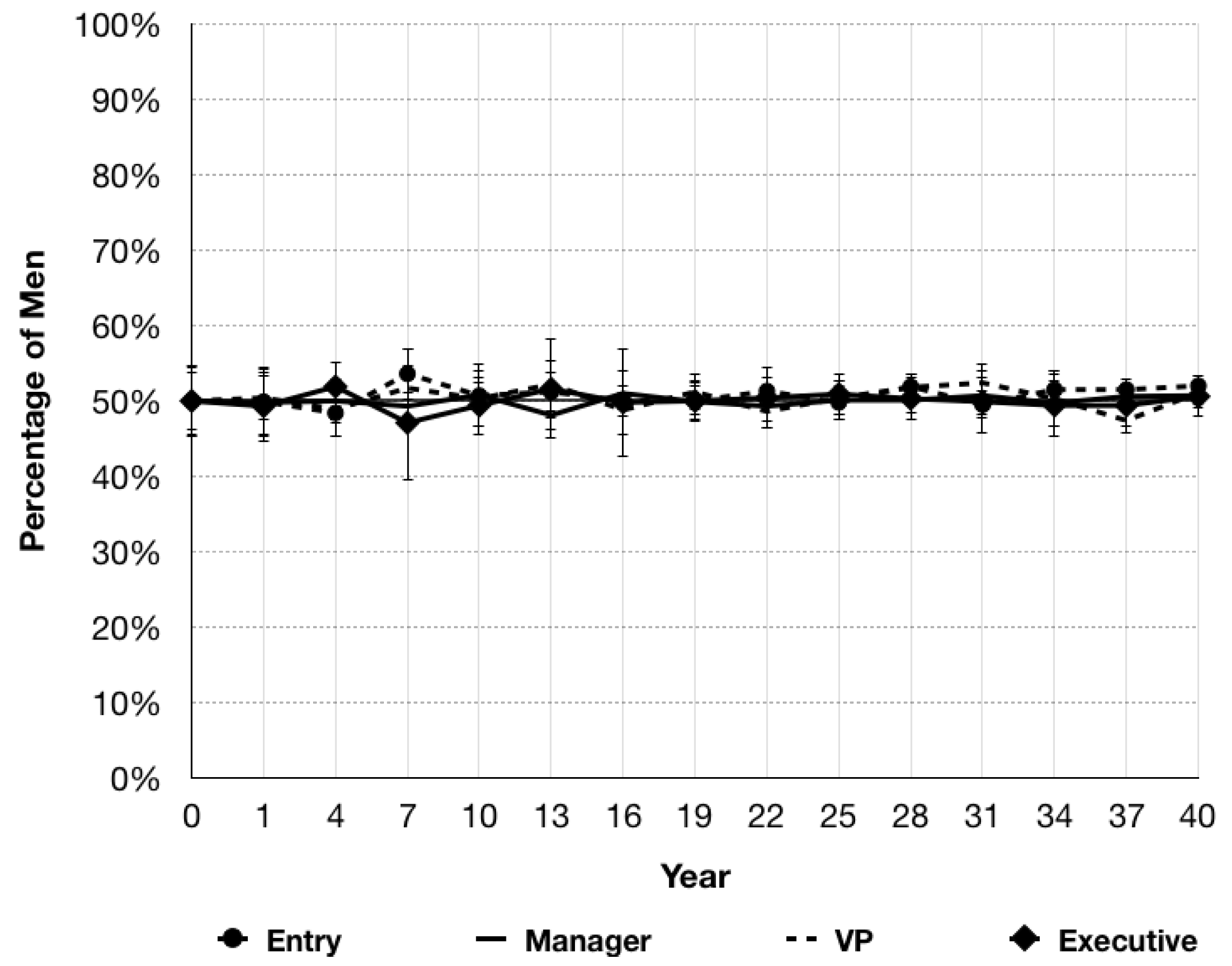
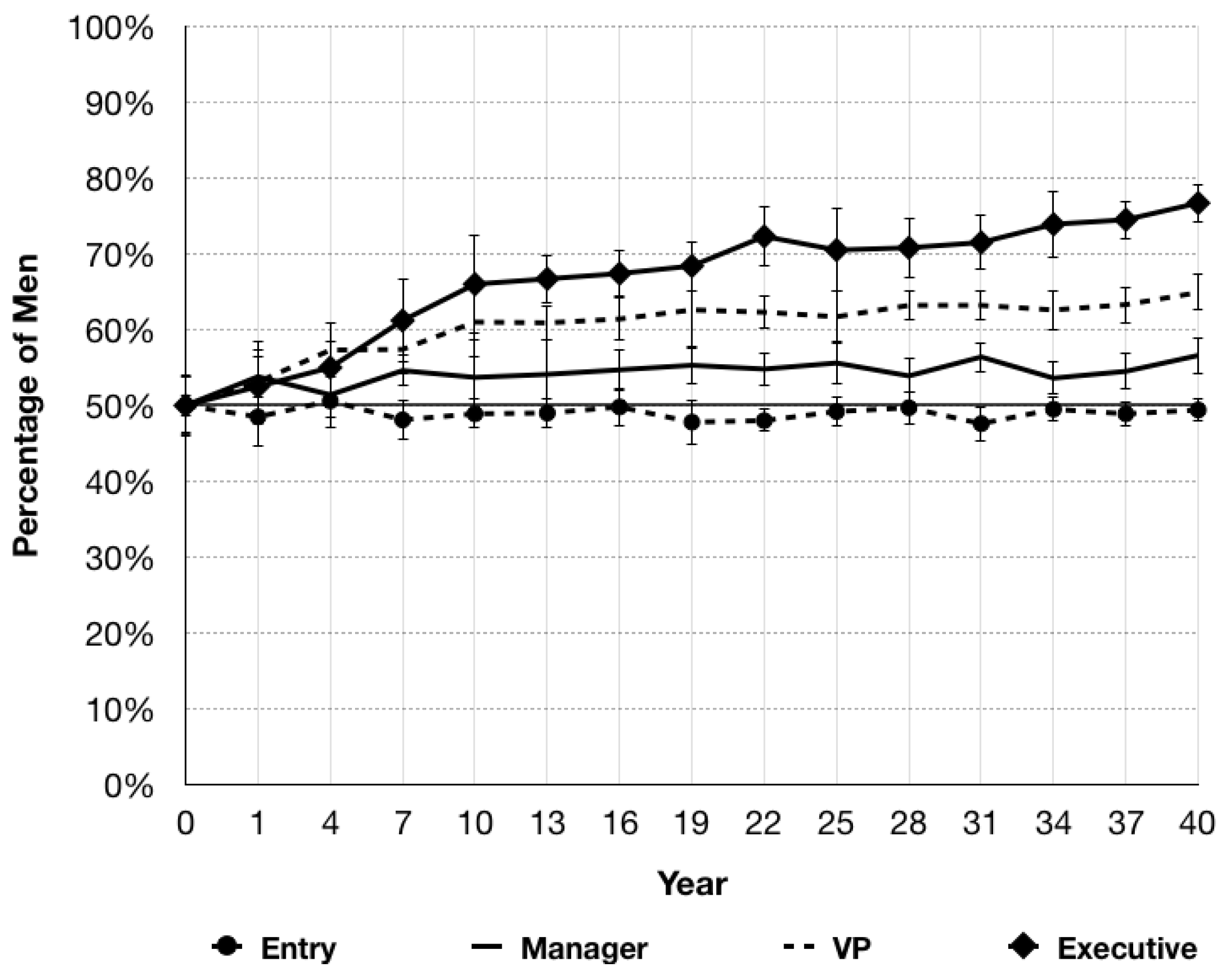

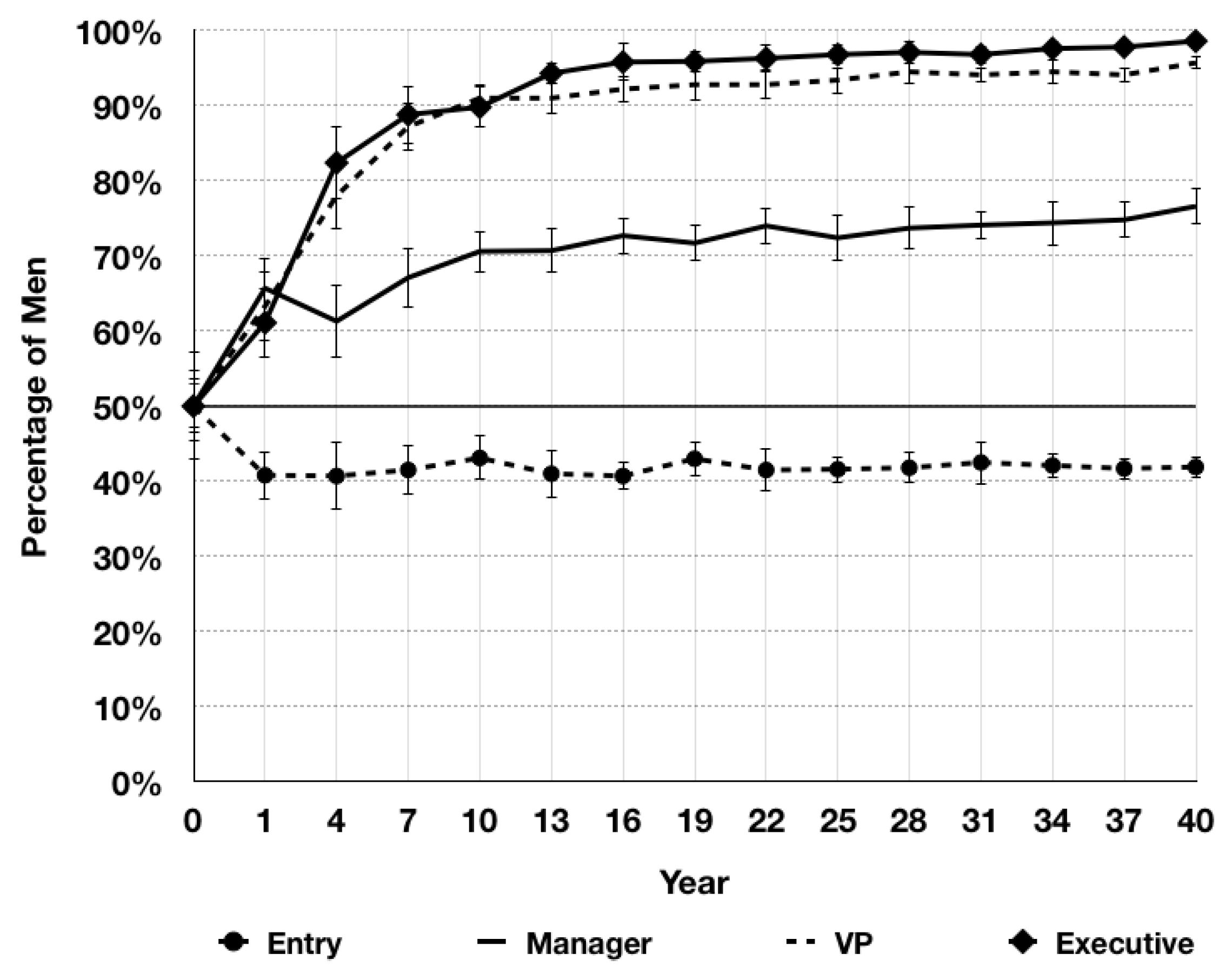
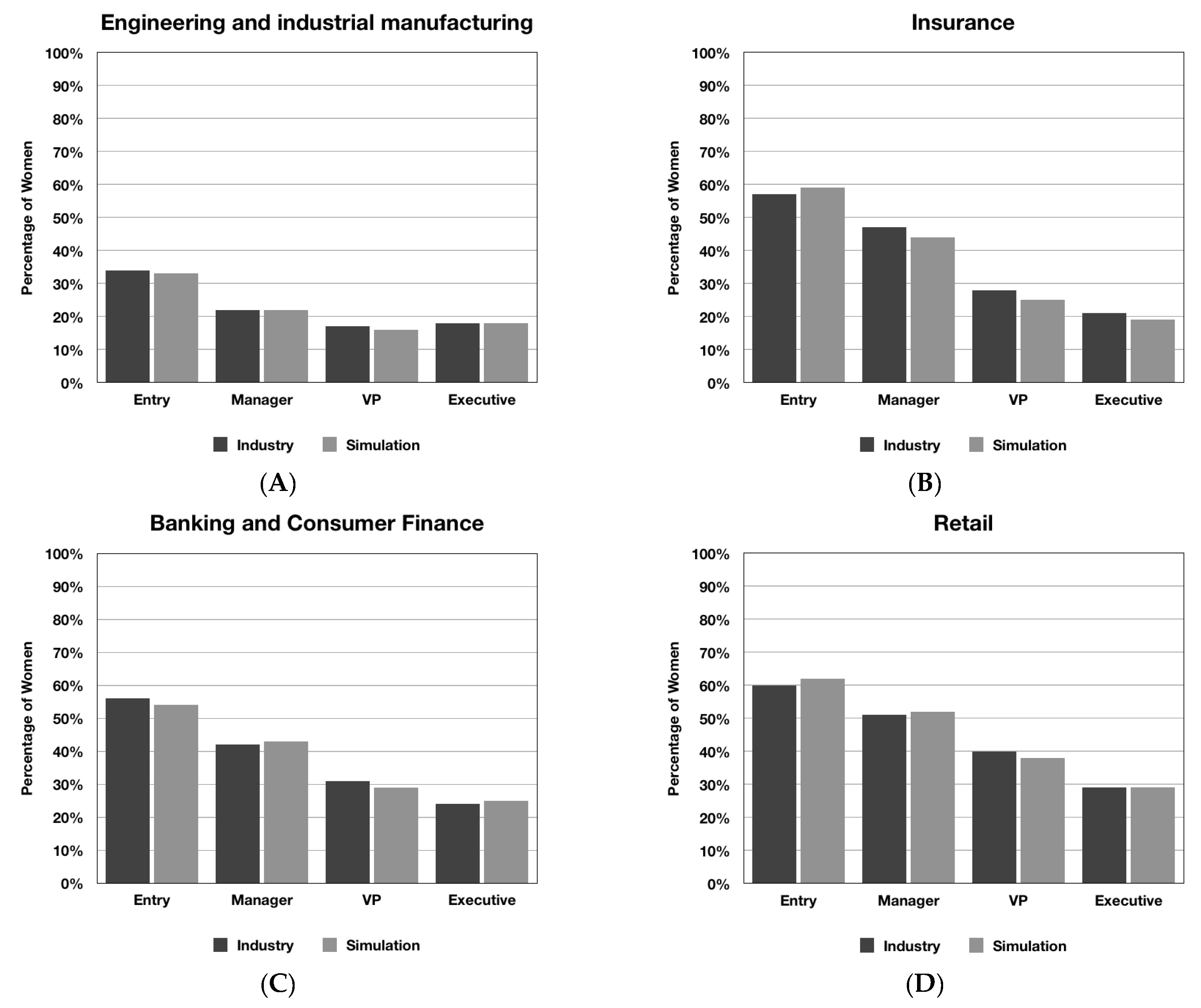

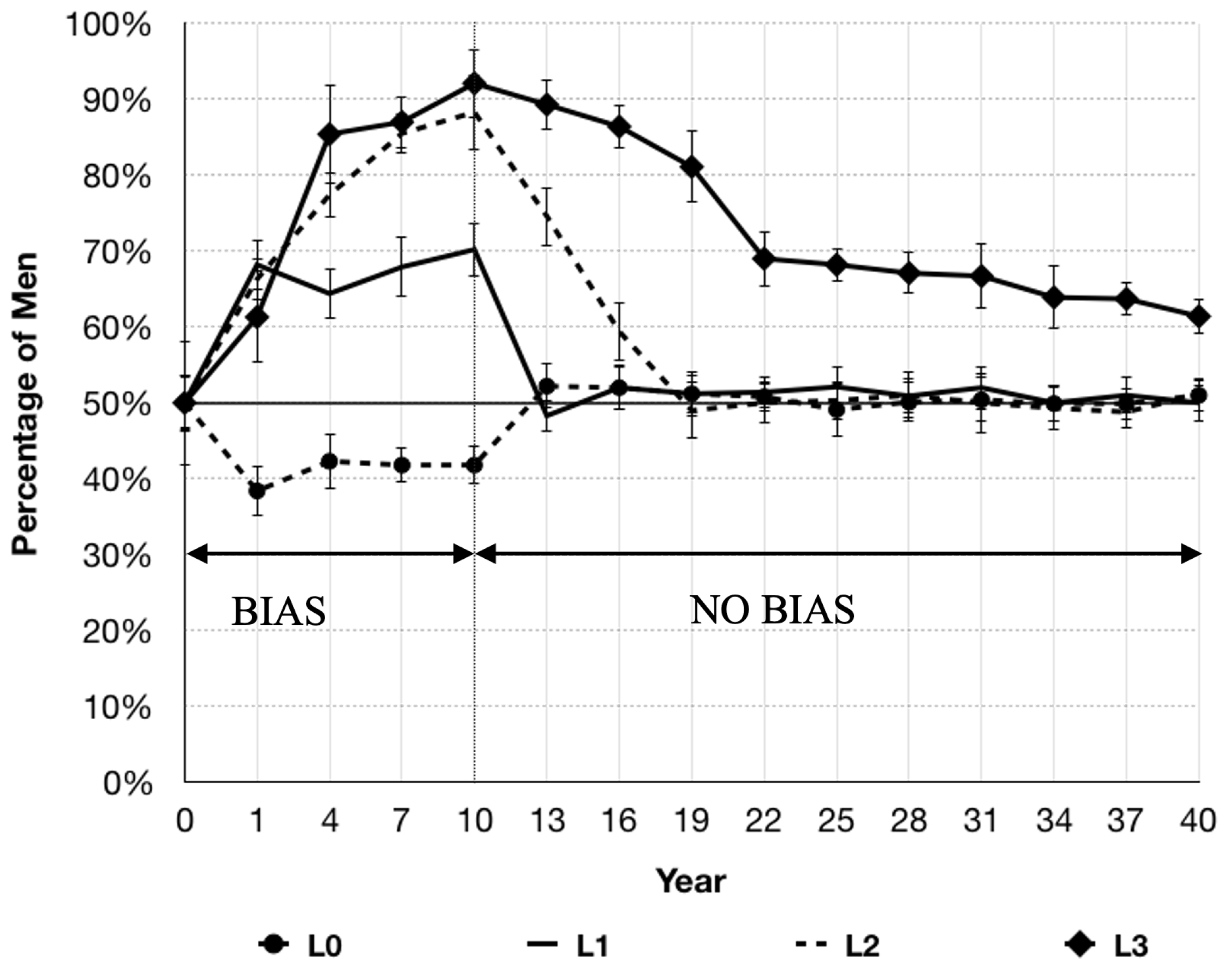

| Variable Name | Variable Description |
|---|---|
| rank | The level of the employee within the organization |
| start-date | The date when the employee joined the company |
| start-date-in-rank | The date when the employee first reached a certain rank |
| tenure-in-rank | How much time the employee has been at a certain rank |
| seniority | A normalized variable [0–1.0] that reflects how long the employee has been at this rank, relative to all employees at the same rank |
| promotion-score | A score that combines the employee’s seniority and promotion biases |
| times-passed-over | The number of times someone from the same level with lower seniority was promoted |
| hr-events | A list of HR-related events such as being hired or promoted |
| Parameter Name | Parameter Value |
|---|---|
| Simulation duration (in years) | 40 |
| Number of repetitions of each simulation | 10 |
| Initial company size | 300 |
| Initial gender balance (male-female) | 50–50 |
| Promotion bias level | 0, 0.1, 0.3, 0.5 |
| Promotion bias duration | N/A (exp. 1), 10 (exp. 3) |
| Hiring bias | 0 |
| Promotion pool size | 15% |
| Termination pool size | 50% |
| Promotion Bias | Hiring Bias | Industry Simulated | Variability Score |
|---|---|---|---|
| 0.3 | 0.4 | Engineering and Industrial Manufacturing | 0.007 |
| 0.3 | −0.1 | Insurance | 0.024 |
| 0.2 | 0 | Banking and Consumer Finance | 0.017 |
| 0.2 | −0.2 | Retail | 0.015 |
Disclaimer/Publisher’s Note: The statements, opinions and data contained in all publications are solely those of the individual author(s) and contributor(s) and not of MDPI and/or the editor(s). MDPI and/or the editor(s) disclaim responsibility for any injury to people or property resulting from any ideas, methods, instructions or products referred to in the content. |
© 2023 by the authors. Licensee MDPI, Basel, Switzerland. This article is an open access article distributed under the terms and conditions of the Creative Commons Attribution (CC BY) license (https://creativecommons.org/licenses/by/4.0/).
Share and Cite
Zhang, C.; Gaudiano, P. An Agent-Based Simulation of How Promotion Biases Impact Corporate Gender Diversity. Appl. Sci. 2023, 13, 2457. https://doi.org/10.3390/app13042457
Zhang C, Gaudiano P. An Agent-Based Simulation of How Promotion Biases Impact Corporate Gender Diversity. Applied Sciences. 2023; 13(4):2457. https://doi.org/10.3390/app13042457
Chicago/Turabian StyleZhang, Chibin, and Paolo Gaudiano. 2023. "An Agent-Based Simulation of How Promotion Biases Impact Corporate Gender Diversity" Applied Sciences 13, no. 4: 2457. https://doi.org/10.3390/app13042457
APA StyleZhang, C., & Gaudiano, P. (2023). An Agent-Based Simulation of How Promotion Biases Impact Corporate Gender Diversity. Applied Sciences, 13(4), 2457. https://doi.org/10.3390/app13042457






